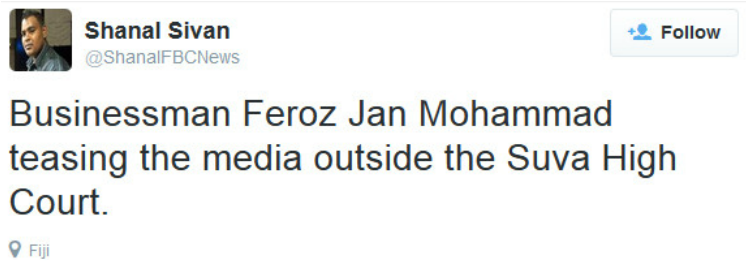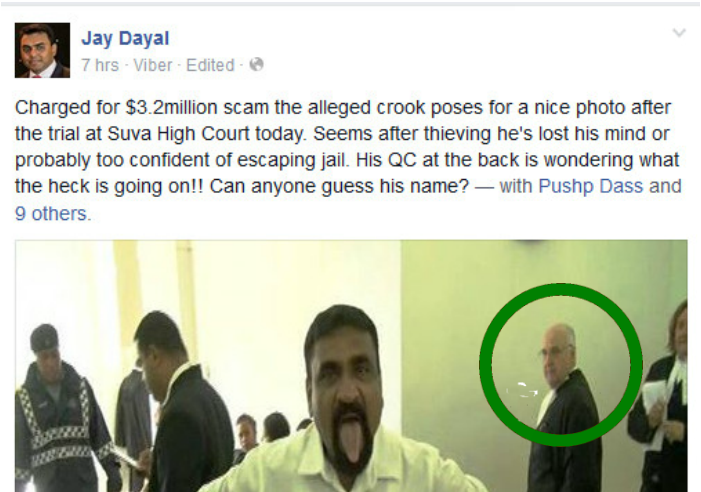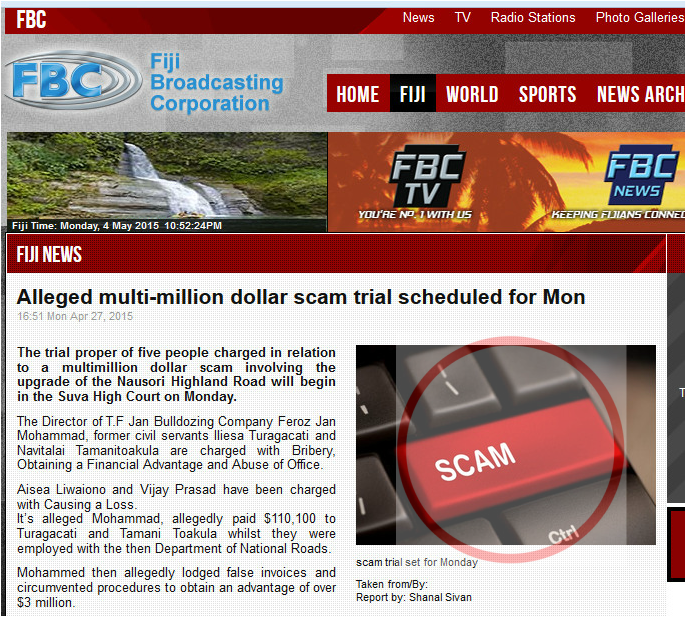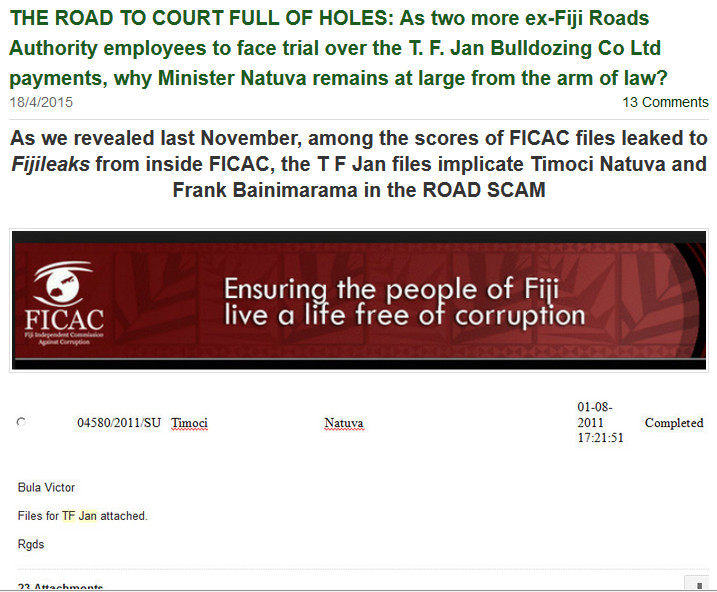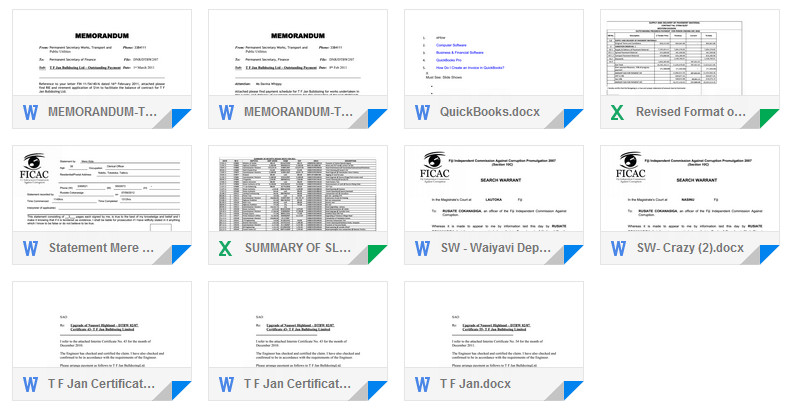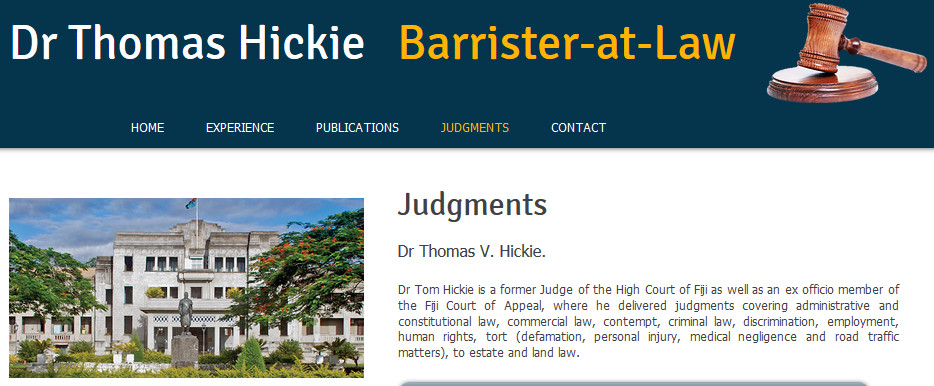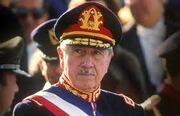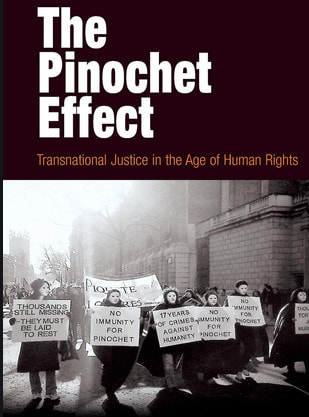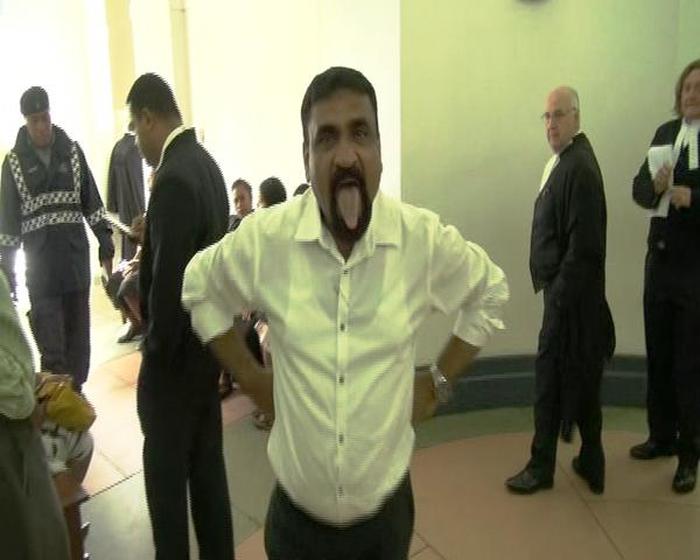
BULLSEYE:
BA Businessman JAY DAYAL SPEAKS FOR US ALL:
CENSORSHIP STILL IN FULL SWING: FBC replaces photo in court story!
In court today Mohammed’s lawyer Dr. Thomas Hickie asked for further documents to be obtained from the Fiji Roads Authority.
The trial was supposed to have started today.
However, it was adjourned to next week to enable lawyers to get the documents.
Both the parties have agreed that the prosecutors, the Fiji Independent Commission against corruption will produce ten witnesses.
The trial will be heard by Judge Justice Paul Madigan. Source: FBC News, 27 April 2015
- Barrister: 2001 NSW
- 2009 England and Wales (Gray's Inn)
- Solicitor: 1983 NSW
- 1989 Victoria
- BA (Hons) LLB PhD (UNSW)
Dr Tom Hickie brings to his practice his background as a judge, barrister, solicitor, lecturer, author and sports administrator.
A former Judge of the High Court of Fiji as well as an ex officio member of the Fiji Court of Appeal, his ability to cover a wide of area of law was recognised when serving on the bench in Fiji where he delivered judgments covering administrative and constitutional law, commercial law, contempt, criminal law, discrimination, employment, human rights, tort (defamation, personal injury, medical negligence and road traffic matters), to estate and land law.
In 2009, he was Called to the Bar of England and Wales (Gray's Inn) and joined 7 Bedford Row Chambers (one of London's leading common law sets) where he remains a Door Tenant.
In 2012, he returned to Australia and the NSW Bar where he has a broad practice reflecting his wide ranging career and interests.
He also continues to teach law as a Sessional Lecturer at the University of NSW.
Specific Areas of Practice
- Administrative and Constitutional
- Commercial
- Civil and Human Rights
- Criminal Law
- Industrial/Employment
- Inquests and Commissions of Inquiry
- Personal Injury
- Sports Law
As a member of the Bars of both NSW and England and Wales, he has practised in the area of Sports Law as well as been the Course Coordinator of 'Sport and the Law' at the University of NSW for over a decade (being jointly awarded in 2005 the Vice-Chancellor's Award for Sessional Teaching).
He also taught in the area as an Adjunct Professor with the Boston University Sydney Internship Program, as a Sessional Lecturer in the LLM distance program at the University of New England, as well as lectured to the Bars of NSW and Jamaica, and practitioners in Fiji.
Professional Memberships
- NSW Bar
- Bar of England & Wales
Recent Publications Book
- Donna T. Spears and Thomas V. Hickie, Criminal Law for Common Law States, LexisNexis Butterworths, Chatswood, 2009.
- Thomas V. Hickie, Anthony T. Hughes, Deborah Healey and Jocelynne A. Scutt (eds), Essays in Sport and the Law, Australian Society for Sports History (ASSH) Studies Series, No. 24, Melbourne, 2008.
- Mary Bushby and Thomas V. Hickie (eds), Rugby History: The Remaking of the Class Game, ASSH Studies Series, No. 22, Melbourne, 2007.
- Thomas V. Hickie and Mary Bushby, 'Rugby at the Crossroads - A Case Study of Sydney University Football Club 1995-97: Grafting professionalism on to the amateur ideal', in Greg Ryan (ed.), The Changing Face of Rugby, Cambridge Scholars Publishing, Newcastle Upon Tyne, 2008.
- Thomas V. Hickie and Marie Chan (eds), 2001 Fiji Law Reports, High Court of Fiji and University of South Pacific Bookshop, Suva, 2008.
Presentation of hypotheticals as part of a panel of barristers presenting a Summer CPD Sports Law Series, 7 Bedford Row Chambers for London practitioners:'Football Governance - Getting It Right or Getting It Wrong', (Commercial, Company and Criminal Law), 8 July 2011;
'Players Behaving Badly - Divergent Perspectives', (Personal Injury, Clinical Negligence, Employment and Criminal Law), 30 June 2011;
2010
Presentation, 'Courage and Fiji: A view from a former member of the Bench', Association of Gray's Inn Students, London, 27 April 2010.
2009
Presentation, 'Courage and Fiji: A view from a former member of the Bench', University of Western Sydney London Alumni, London, 6 November 2009
In-house seminar, 'An Introduction Sports Law', 7 Bedford Row Chambers, London, 5 November 2009.
2008
Conference Lecture: 'Challenges for Prosecutors: A View from the Bench', presented to the 10th Annual DPP's Conference, Yanuca, Fiji Islands, 10 December 2008.
Conference Lecture: 'Recent issues in "Sport and the Law"', presented to the 10th Annual Attorney-General's Conference, Yanuca, Fiji Islands, 28 November 2008.
Presentation, 'Courage, Fiji and the Judicial Oath', University of NSW Law Society, UNSW Law School, Sydney, 18 September 2008.
Joint Presentation with Justice Nazhat Shameem, 'Contempt and the Media - the Do's and Don't's', separate presentations to journalists with Fiji TV, Fiji Radio and Fiji Times.
2007
Conference Paper: 'Thank God for El Masri as Madame Defarge is alive and well and living in Australian Sport', Sporting Traditions XVI Conference, The Australian Society for Sports History (ASSH), Canberra, 30 June 2007.
Lecture/Address: 'Development of Sports Law', presented to the NSW Bar Association, Sydney Downtown Mini Conference, 17 March 2007.
2006
Lecture/Address: 'The Development of "Sport and the Law" Over the Last Four Decades', presented to the Jamaican Bar, University of West Indies, Kingston, 15 July 2006.
2005
Conference Address: 'Sydney University Football Club: A Case Study in Change Management', to Royal Australasian College of Medical Administrators, Melbourne, 25 August 2005.
2003
Conference Keynote Address: 'The Amateur Ideal in the Era of Professional Rugby', presented to 'Rugby, History and the Remaking of the Class Game', organised by the Australian Society for Sports History (ASSH), University of NSW, 8 November 2003.
2002
Conference Paper: 'The PM, the Attorney-General and the Role of the Legal System: a clear vision and understanding', presented to 'Thirty Years Later: The Whitlam Government as Modernist Politics', National Key Centre for Australian Studies and the Parliamentary Studies Unit, Faculty of Arts, Monash University, Old Parliament House Canberra, 2-3 December 2002.
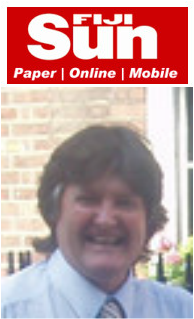 Hickie
Hickie How Parmanandam ended up in prison for Contempt of Court: The Untold Story
By VICTOR LAL
In passing judgment on the Fiji Times and its select executives who admitted contempt of court, Justice Thomas Hickie recalled two previous judgments for contempt of court by way of ‘scandalising the court or a judge” – Parmanandam v Attorney-General (1972) and Mahendra Chaudhry v Attorney General (1999).
What was the real story behind that court case involving Vijaya Parmanandam? How did he end up before the court charged with contempt and was later committed to prison for six months?
In a cruel twist of irony, Parmanandam was convicted and sent to prison after police had allegedly obtained tape recordings of his speech from a Fiji Times reporter (Adishwar 'Spike' Padarath) who had come armed with his own tape recorder to the meeting. The original tape recording by the NFP’s soundman had been hastily destroyed on Parmanandam’s request. The circumstances leading to Parmanandam’s conviction has never been told before, for the radical lawyer and politician, including his defence lawyer at the trial and political mentor, the late Siddiq Koya, as well as the late Ratu Sir Kamisese Mara, took to their graveyards the circumstances relating to John Nimmo’s appointment as Chief Justice of Fiji.
Looking back at my old notes and listening to tape recordings of Parmanandam’s interview with me in 1985 when I was collecting material for my book which was originally titled Fiji’ Racial Politics: The Coming Coup (but was subsequently published following the 1987 coup as Fiji: Coups in Paradise – Race, Politics and Military Intervention), Parmanandam was ‘inspired’ by Koya to attack the judges. He had just won pre-selection for the Navua seat (manipulated by Koya as leader of the NFP) and he told a few top NFP politicians just before the meeting in the Suva Civic Centre on 28 March 1972 that he was going to attack the judges at that meeting.
The NFP politicians pleaded with Parmanandam to talk about bread and butter issues but he told them that his mind was made up – to attack the judges. He was, as those of us who knew him personally and socially, a real ‘political nutter’ and he was Koya’s protégé. So he lashed out with a speech against the judges. When one high-ranking NFP politician turned to Koya and said at the meeting, “Is this proper”, Koya replied, “Oh, yes”. Parmanandam thundered. He was very nervous and grasped the mike and said to an old family neighbour of ours, Shiu (of Shius Sound System), are you recording this?
Parmanandam told the crowd: “...This attack is being made on the NFP platform to clean the judiciary once and for all so that in future there would be no need for any further attacks on the judiciary...The Alliance government, through the legal and judicial services commission, has completely disregarded the majority opinion of the practicing solicitors of Fiji...Not so long ago you will recall that my friend Mr. K. C Ramrakha led an attack on the proposed, or the then proposed appointment of the present Chief Justice, Chief Justice Sir John Nimmo.
“You will recall that there was requisitioned a special general meeting of the Law Society wherein 17 lawyers were against this proposed appointment...Despite this, ladies and gentlemen, the Alliance Government went ahead with the appointment. This particular gentleman, Sir John Nimmo, an Australian, who was appointed Chief Justice of Fiji, you will recall his salary, or part of his salary, is paid by the Australian Government. Now where is our independence? Have we sold our independence for a few measly thousand dollars to Australia? This is the position ladies and gentlemen, under the present Alliance Government.
“Now, ladies and gentlemen, there is a very cherished principle in English law and British tradition that a man must not be condemned without his hearing, that a man must be given his right to be heard. Yet the very same Chief Justice, Sir John Nimmo condemned recently two Suva lawyers who were not even present, who were not even charged. “This is a Chief Justice acting under the Alliance Government. When your very throne of the judiciary, the base of the judiciary, acts in such a manner then the whole judiciary seems, or gives the impression, that it is cracking up. It is akin somewhat to the commencement of the decline and fall of the Greece-Roman Empire. And what have you? At present we have sitting today in Fiji a Fiji Court of Appeal the president of which is the Chief Justice, Sir John Nimmo ... Now you have three judges sitting, two of them are appointed from judges sitting, two of them are appointed from New Zealand. They are also retired judges.
“Yet they brought over by the Chief Justice of Fiji who is president of the court of appeal. Their future appointments in sessions depend entirely upon him. What is the position when a judgment of his goes up to be decided by these gentlemen from New Zealand or locally retired judges. These all gentlemen are different aspects of the judiciary which needs cleaning up. And if you vote NFP into power, judiciary will be cleaned up once and for all.”
It was not long before the meeting ended when the news of his speech spread and the police began looking for the tape. Now it dawned on Parmanandam that he might be in deep trouble. No worries, a Fiji Times newsman was sitting there with the company’s tape and the police allegedly took that over. Later, Koya would maliciously attack the newspaperman, for allegedly handing over the tape. Anxious that Parmanandam, a political colleague who should not go to prison for contempt of court, as that would reflect badly on the NFP as a party, one senior NFP politician travelled to Lautoka and spoke to the senior lawyer and doyen of Fiji politics, S. B. Patel. He immediately rang CJ Nimmo who said if Parmanandam apologised he would discharge him with a warning provided there were no further attacks.
There was widespread consensus among the NFP hierarchy that ‘a son of the soil’, Justice Moti Tikaram (later Sir Moti), must become the first Chief Justice of Fiji but according to one NFP respondent of mine, both Koya and Ratu Mara had been secretly looking for one Khalid Hassan in London, who would later take up a judicial posting in Nigeria. It should be noted that the NFP hierarchy had not informed Sir Moti about their choice nor was he aware of the party’s preference for him as Fiji’s first post independence Chief Justice.
Koya was desperate to keep Sir Moti out of the job. Koya had kept this secret from his NFP colleagues and persuaded them to attack Nimmo because he said Nimmo was a foreigner and a foreigner should not be Fiji’s CJ. He was suddenly playing the “bad cop”. Parmanandam, who was in thrall of Koya, and who believed that the Navua seat he got was because of his political mentor, took the bait, and paid the price.
Koya and Mara later asked Sir Garfield Barwick, the Chief Justice of Australia, for a CJ for Fiji and he nominated Nimmo. The secret behind the scene appointment of Nimmo was one of the many reasons which split the NFP. Meanwhile, Parmanandam was only willing to offer conditional apology, in deference to, and advice from Koya, and ended up spending six months in gaol. Certified “sick”, Parmanandam spent most of the time in the hospital bed in Suva Gaol reading comic books, so he claimed.
When he came out, a top NFP politician helped him by asking Sir John Falvey, Ratu Mara’s Attorney-General in the Alliance Party government, not to kick him out as a lawyer. Parmanandam rewarded the NFP by joining the Alliance Party and became one of the party’s bitter critics. In June 1972, Justice Clifford H. Grant in the Supreme Court dismissed his (Parmanandam’s) application for discharge based solely on an apology contained in paragraph 3 of his affidavit. During his previous trial the Court had held that a form of apology then tendered did not constitute an unqualified, and unconditional apology and that it could not be treated as a sincere purging of Parmanandam’s contempt. Grant upheld the ruling.
In 1977, Koya, Parmanandam, Ramrakha and Grant (by now Sir Clifford) would face each other during the famous constitutional crisis when the NFP won the general election but was not able to form a government on its own because of the razor-edge majority of 26 seats. On 5 April 1977 Ratu Mara resigned as Prime Minister and Ramrakha and Mrs Irene Jai Narayan informed the Governor-General Ratu George Cakobau that the NFP would proceed to form a government. As I have recorded elsewhere, Koya was not to become the first Prime Minister of Indo-Fijian origin. When he arrived at Government House to keep his 4.30pm appointment with the Governor-General, he was told that Ratu Mara had already been sworn in as Prime Minister for second term, to head an Alliance minority government. Koya later reported to the NFP parliamentarians that the Governor-General had given two reasons for this: one was ‘security’ and the other that in his (Ratu George’s) judgment Ratu Mara commanded majority support in the country.
Thereafter followed much recrimination and bad faith on all sides. Koya claimed that Ratu Mara and his Alliance Party agreed to lead a minority government because they did not want an Indo-Fijian to become Prime Minister. Their decision was “an insult to the Indian community and its self-respect”. Ratu Mara charged that he was responding to the command of a paramount chief to take up the job, and raked an old wound by an oblique reference to the refusal by Indo-Fijians to join the war effort when the free world was threatened by the Nazis and the Japanese imperial forces.
Parmanandam, a dissident Koya supporter, in a public meeting hinted that Koya had been disowned by two of his colleagues and erstwhile rivals, Mrs Narayan and Ramrakha, and the Governor-General had, therefore, not appointed Koya the Prime Minister. He claimed that the two had driven to Government House while the NFP parliamentarians were discussing the formation of a new government. Mrs Narayan and Ramrakha denied the allegations as “sheer lies and mere fabrication”. Meanwhile, Koya sought parallels in Australia, to the 1975 Whitlam crisis: “This may be legal and constitutional question for someone else to decide, but I would equate this position to a minority government installed in Australia by the Governor-General, Sir John Kerr.”
Who advised the Governor-General of Fiji? There was wide-spread belief that it was the then Chief Justice of Fiji, Sir Clifford Grant. Also, the NFP was of the opinion that Sir Clifford had himself drafted the G-G’s official statement. In Ramrakha’s words, ‘an interesting parallel to be found in this is that Sir Garfield Barwick, Chief Justice of Australia, also gave advise to Sir John Kerr, the G-G of Australia in a somewhat similar crisis”.
On Sir Clifford’s role, Ramrakha wrote years later: “Everyone was using the back entrance to Government House in Suva that day. We had tried to sue the front entrance to be turned away by the guard. But that day, Sir Clifford had gone there by the front entrance. No one saw him. Everyone was concentrating on the back entrance. Sid Koya later said that when he entered the Government-General’s room, he thought he saw Sir Clifford leaving the room. It was Sir Clifford who gave last minute advice on which Ratu Sir George acted. I know that Sid Koya and his colleagues now know this to be the truth. Yet they wasted all those months trying to lay the blame elsewhere…But then, politics in Fiji is one long stab in the back’.
In 2001, while criticising the affidavits of two of his judicial colleagues against him in the case of CCF v the President, the recently resigned CJ Daniel Fatiaki seemed to confirm Ramrakha’s contention: “In the constitutional history of this country since 1970 there have been at least two albeit not widely publicised occasions, when the Chief Justice of this country gave advice to the Head of State’s representative on what constitutional options were available for him to take. The first, occurred when the former Chief Justice Sir Clifford Grant advised the first Governor-General, Ratu Sir George Cakobau, on his constitutional powers under the 1970 Constitution concerning the appointment of the Prime Minister after the 1977 elections.”
Reflecting on the contempt episode, Parmanandam confessed that he had made a mistake by going along with Koya in attacking CJ Nimmo. He did not realize that Koya was playing both “good cop, and bad cop”. Parmanandam, however, insisted that his apology was not accepted by the Supreme Court because Justice Grant must have had “one eye” for the position of Chief Justice in the foreseeable future.
As to Parmanandam’s scurrilous outburst against the overseas judges, one can say with Justice Cardozo in The Nature of the Judicial Process (1921): “We may try to see things as objectively as we please. None the less, we can never see them with any eyes except our own.”
Whatever the charges and machinations behind CJ Nimmo’s appointment, in legal judgments in Commonwealth jurisdictions, Parmanandam will always be treated as a ‘precedent’ in contempt of court proceedings. And, now in Action No 124 of 2008 in the High Court of Fiji at Suva In re Application by the Attorney General of Fiji [2009] – in the matter of an application by the Attorney-General of Fiji for leave to apply for an Order of Committal against the Fiji Times and its top executives.
